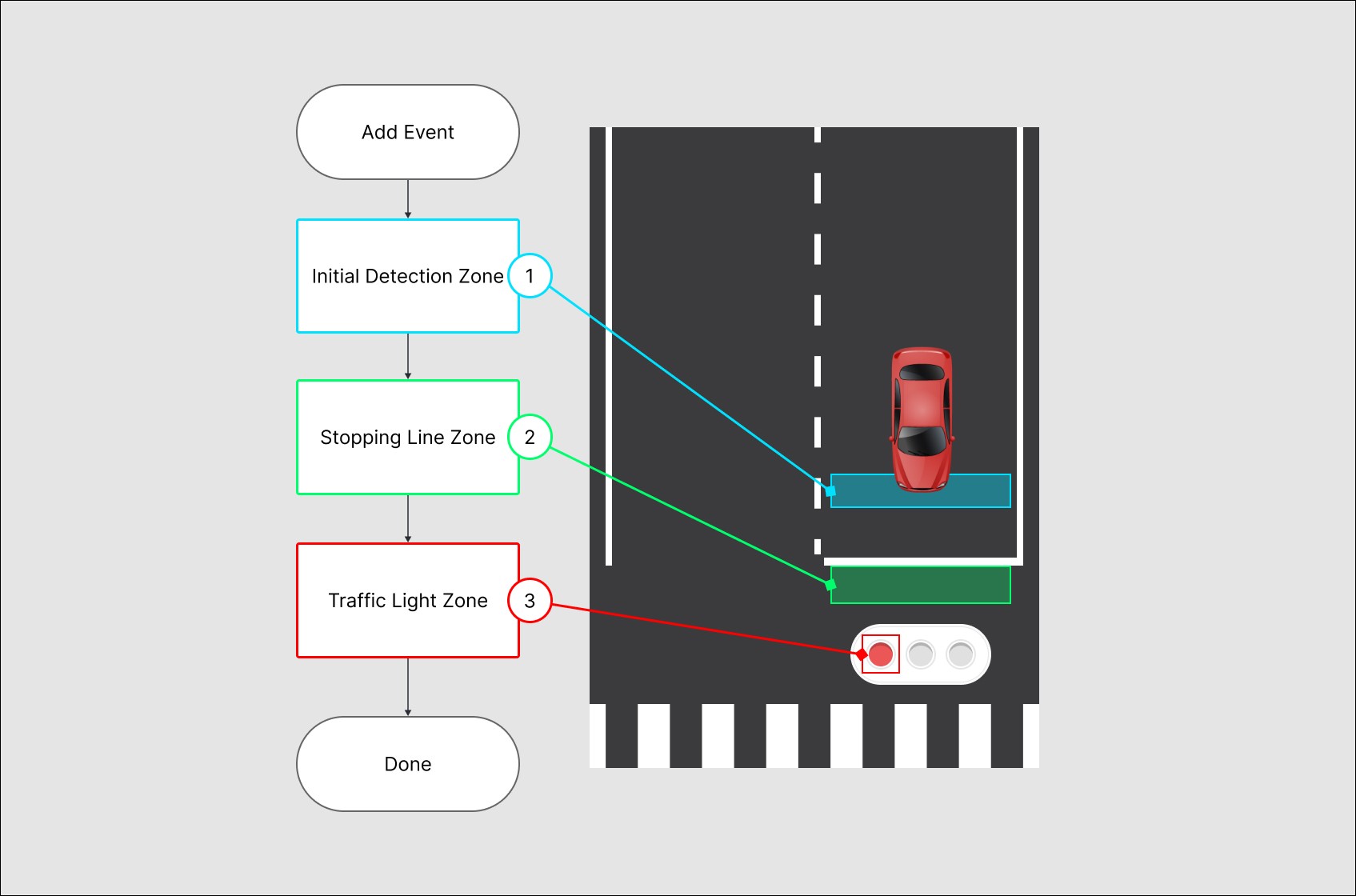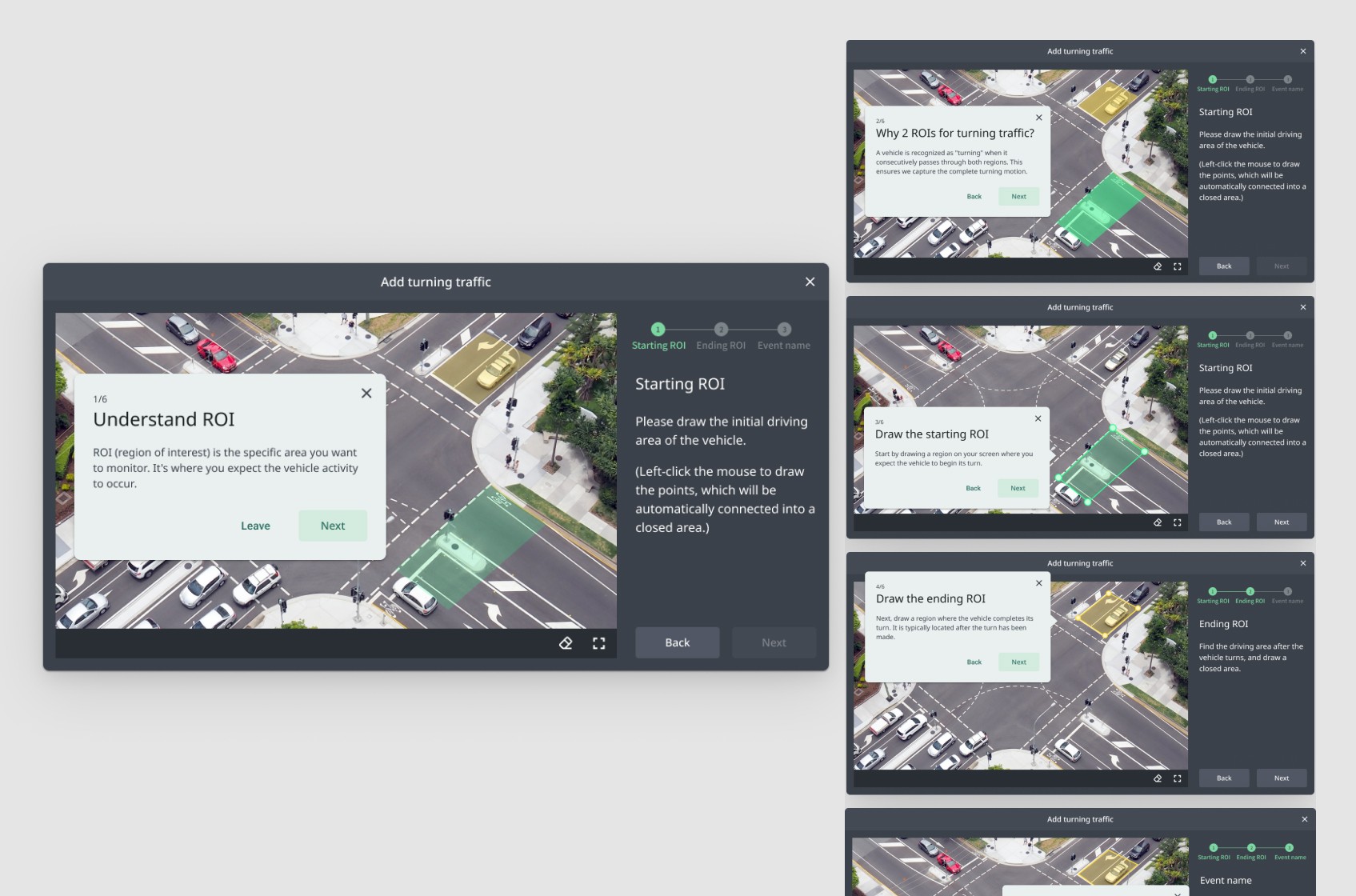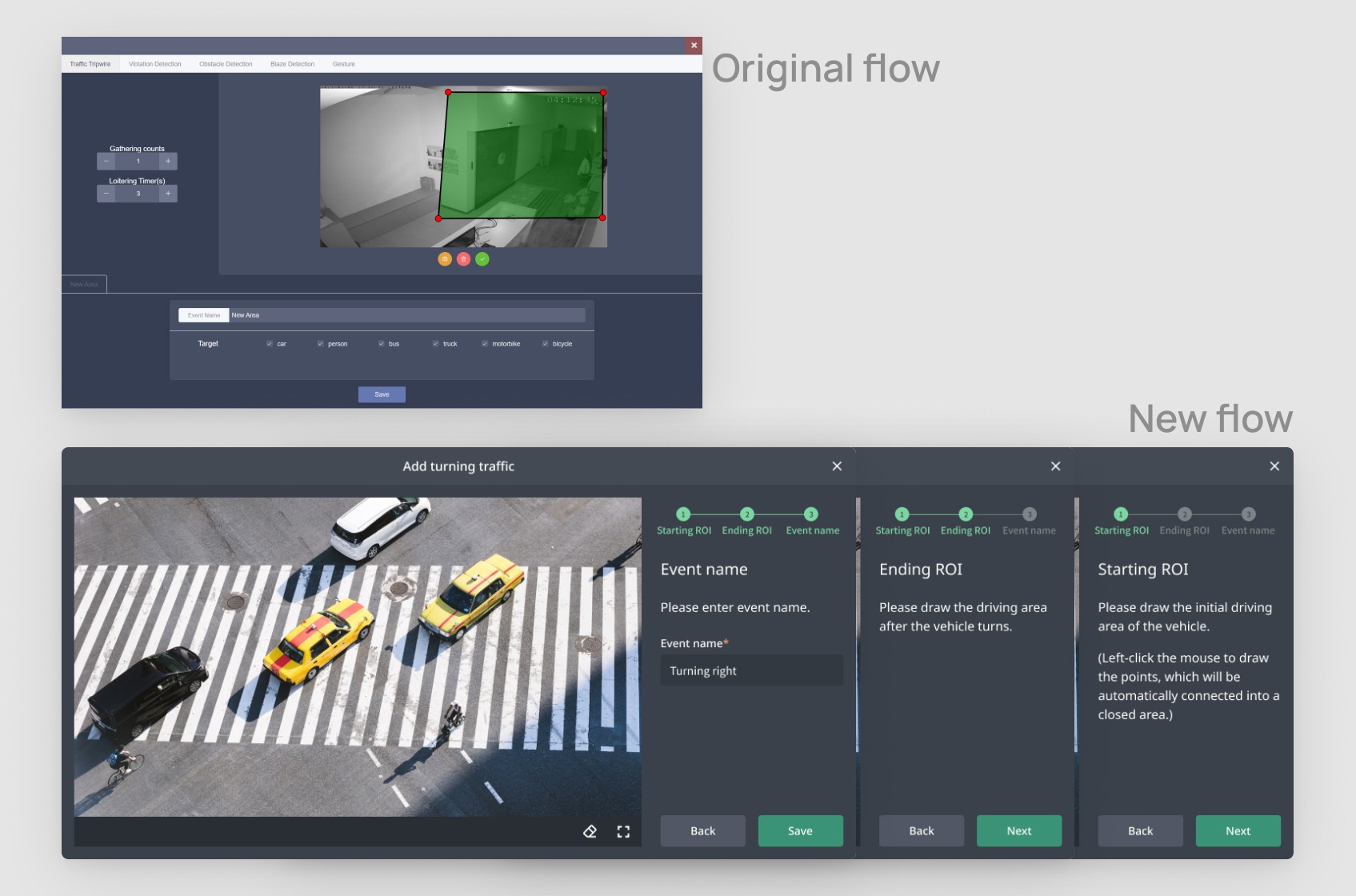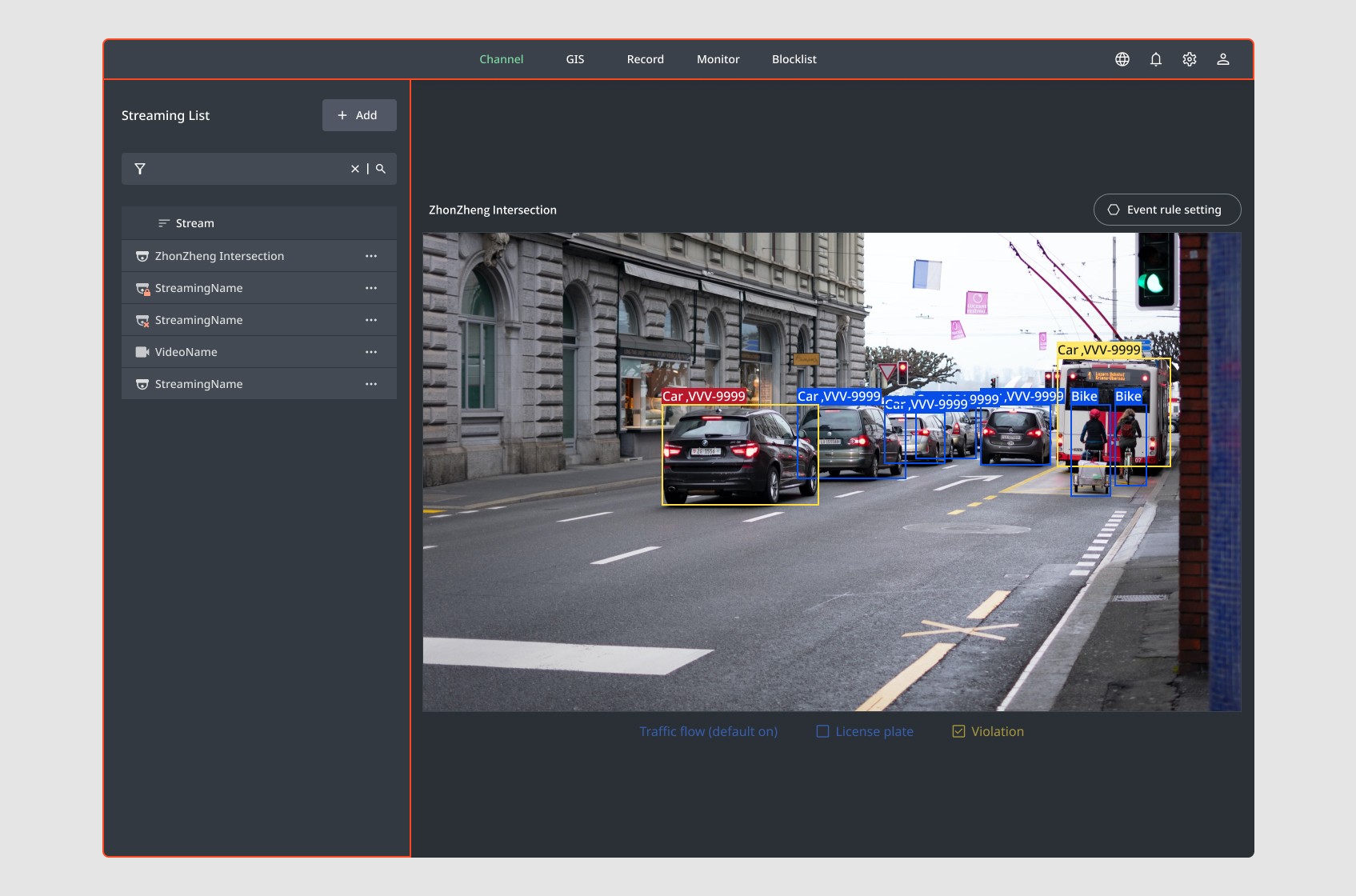AI Traffic Recognition System
AI Traffic Recognition System
AI Traffic Recognition System
Role
Role
Role
Product Designer
Product Designer
Product Designer
Timeframe
Timeframe
Timeframe
Dec 2022 - Apr 2023
Dec 2022 - Apr 2023
Dec 2022 - Apr 2023
Achievement
Achievement
Achievement
Simplifying AI Recognition for System Integrators
Enhance User Efficiency
Simplifying AI Recognition for System Integrators
Enhance User Efficiency
Simplifying AI Recognition for System Integrators
Enhance User Efficiency



Background
We built a new 0-1 product from the groud up that combines AI models for traffic analysis, license plate recognition, and violation detection. This software allows users to export recognition results for reporting.
Problem Statement
Users were unsure and confused about logic settings of AI recognition which leads to failing of tasks and inaccurate recognition results.

With numerous types of traffic violations, let's take running a red light as an example.
Here, the zones play specific roles:
Initial Detection Zone: Verifies approaching vehicles in this lane.
Stopping Line Zone: Crossing during a red light in this zone is a violation.
Traffic Light Zone: Monitors the traffic light for changes in color.
The sheer number of traffic rules and the complexity of zone drawing make it difficult for users to complete recognition settings.
The Discovery Phase
Clarify Users
Through internal interviews with sales and FAEs, I identified system integrators as our target user and define their needs.
Clarify Scope
Collaborated with the project manager to ensure product scope aligned with the company's market strategy and internal development strengths
Clarify Constraint
Through discussions with AI engineers, I clarified the technical constraints visual AI and the configuration rules, enabling the creation of a realistic and achievable design solution.
Background
We built a new 0-1 product from the groud up that combines AI models for traffic analysis, license plate recognition, and violation detection. This software allows users to export recognition results for reporting.
Problem Statement
Users were unsure and confused about logic settings of AI recognition which leads to failing of tasks and inaccurate recognition results.

With numerous types of traffic violations, let's take running a red light as an example.
Here, the zones play specific roles:
Initial Detection Zone: Verifies approaching vehicles in this lane.
Stopping Line Zone: Crossing during a red light in this zone is a violation.
Traffic Light Zone: Monitors the traffic light for changes in color.
The sheer number of traffic rules and the complexity of zone drawing make it difficult for users to complete recognition settings.
The Discovery Phase
Clarify Users
Through internal interviews with sales and FAEs, I identified system integrators as our target user and define their needs.
Clarify Scope
Collaborated with the project manager to ensure product scope aligned with the company's market strategy and internal development strengths
Clarify Constraint
Through discussions with AI engineers, I clarified the technical constraints visual AI and the configuration rules, enabling the creation of a realistic and achievable design solution.
Background
We built a new 0-1 product from the groud up that combines AI models for traffic analysis, license plate recognition, and violation detection. This software allows users to export recognition results for reporting.
Problem Statement
Users were unsure and confused about logic settings of AI recognition which leads to failing of tasks and inaccurate recognition results.

With numerous types of traffic violations, let's take running a red light as an example.
Here, the zones play specific roles:
Initial Detection Zone: Verifies approaching vehicles in this lane.
Stopping Line Zone: Crossing during a red light in this zone is a violation.
Traffic Light Zone: Monitors the traffic light for changes in color.
The sheer number of traffic rules and the complexity of zone drawing make it difficult for users to complete recognition settings.
The Discovery Phase
Clarify Users
Through internal interviews with sales and FAEs, I identified system integrators as our target user and define their needs.
Clarify Scope
Collaborated with the project manager to ensure product scope aligned with the company's market strategy and internal development strengths
Clarify Constraint
Through discussions with AI engineers, I clarified the technical constraints visual AI and the configuration rules, enabling the creation of a realistic and achievable design solution.

Design Solutions
Demystify Logic Settings With Interactive Guided Tour

Simplified Setup to Lower Errors
Break down recognition settings into clear steps with predefined options for common tasks. This user-friendly approach reduces complexity and minimizes errors during configuration.

Enhance Visual Hierarchy and Accessibility
Organized the interface to prioritize user discovery. This ensures the navigation bar, camera list, event list, and streaming page are visually clear and follow the information architecture, making it easier for users to locate desired features and information.

Usability Testing
This video demonstrates an iterative design process for creating an event, informed by usability testing with 5 internal participants.
Reflection
Given that this is a 0-1 product, I think more discussions and early team alignment are crucial. I could lead more product clarification discussions and facilitated collaborative creation of a unified requirements document format. This ensured clear communication and version control across engineering, design, and product management.

Design Solutions
Demystify Logic Settings With Interactive Guided Tour

Simplified Setup to Lower Errors
Break down recognition settings into clear steps with predefined options for common tasks. This user-friendly approach reduces complexity and minimizes errors during configuration.

Enhance Visual Hierarchy and Accessibility
Organized the interface to prioritize user discovery. This ensures the navigation bar, camera list, event list, and streaming page are visually clear and follow the information architecture, making it easier for users to locate desired features and information.

Usability Testing
This video demonstrates an iterative design process for creating an event, informed by usability testing with 5 internal participants.
Reflection
Given that this is a 0-1 product, I think more discussions and early team alignment are crucial. I could lead more product clarification discussions and facilitated collaborative creation of a unified requirements document format. This ensured clear communication and version control across engineering, design, and product management.

Design Solutions
Demystify Logic Settings With Interactive Guided Tour

Simplified Setup to Lower Errors
Break down recognition settings into clear steps with predefined options for common tasks. This user-friendly approach reduces complexity and minimizes errors during configuration.

Enhance Visual Hierarchy and Accessibility
Organized the interface to prioritize user discovery. This ensures the navigation bar, camera list, event list, and streaming page are visually clear and follow the information architecture, making it easier for users to locate desired features and information.

Usability Testing
This video demonstrates an iterative design process for creating an event, informed by usability testing with 5 internal participants.
Reflection
Given that this is a 0-1 product, I think more discussions and early team alignment are crucial. I could lead more product clarification discussions and facilitated collaborative creation of a unified requirements document format. This ensured clear communication and version control across engineering, design, and product management.